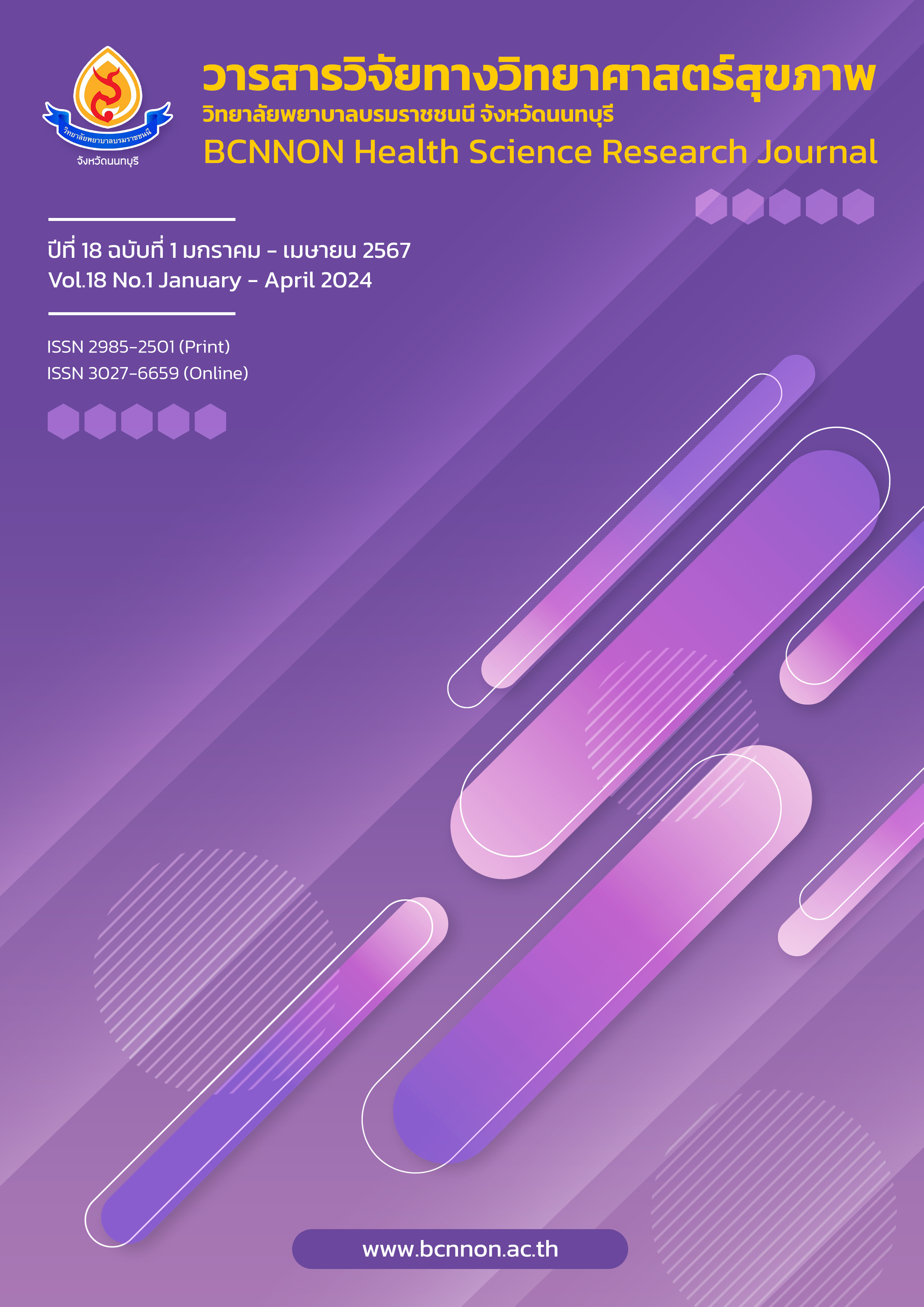การพัฒนารูปแบบการป้องกันการเปิดรับสื่อลามกอนาจารของวัยรุ่นชายในเขตสุขภาพที่ 4
Main Article Content
บทคัดย่อ
บทนำ : การพัฒนาวัยรุ่นชายให้มีการป้องกันการเปิดรับสื่อลามกอนาจาร จะเป็นเกราะในการป้องกันผลของการเปิดรับสื่อลามกอนาจาร
วัตถุประสงค์การวิจัย : เพื่อพัฒนารูปแบบการป้องกันการเปิดรับสื่อลามกอนาจารของวัยรุ่นชาย ในเขตสุขภาพที่ 4
วิธีการวิจัย : การวิจัยและพัฒนา ดำเนินการ 3 ระยะ ได้แก่ ระยะที่ 1) ศึกษาสถานการณ์การป้องกันการเปิดรับสื่อลามกอนาจารฯ ผู้ให้ข้อมูล คือ วัยรุ่นชายอายุ 15-19 ปีจำนวน 374 คน และสัมภาษณ์ข้อมูลเชิงลึกกับบิดามารดา/ผู้ปกครอง เจ้าหน้าที่สาธารณสุข เจ้าหน้าที่ตำรวจ เจ้าหน้าที่กระทรวงดิจิทัล ระยะที่ 2) การพัฒนารูปแบบฯ ได้นำรูปแบบที่พัฒนาขึ้นไปใช้กับตัวอย่างที่เป็นกลุ่มทดลองจำนวน 40 คน ระยะที่ 3) ประเมินผลรูปแบบกับกลุ่มตัวอย่าง เครื่องมือประกอบด้วย แบบสอบถามการป้องกันการเปิดรับสื่อลามกอนาจารของวัยรุ่นชาย ค่าความเที่ยงตรงอยู่ระหว่าง 0.82-1.00 ค่าความเชื่อมั่นที่ .70 วิเคราะห์ข้อมูลโดยใช้ความถี่ ร้อยละ ค่าเฉลี่ย ส่วนเบี่ยงเบนมาตรฐาน และ Independent t-test
ผลการวิจัย : 1) สถานการณ์การป้องกันการเปิดรับสื่อลามกอนาจารของวัยรุ่นชาย พบว่า การป้องกันการเปิดรับสื่อลามกอนาจารอยู่ในระดับปานกลาง 2) รูปแบบประกอบด้วย 7 กิจกรรม ประกอบด้วย รู้ทันเธอ รู้สึกดีที่ไม่ดู แบบอย่างของฉัน ฉันควบคุมเธอได้ แน่วแน่ เอาจริงละนะ และคนสำคัญ และ 3) การประเมินผลรูปแบบ พบว่า กลุ่มทดลองมีการป้องกันการเปิดรับสื่อลามกอนาจารสูงขึ้น และสูงกว่ากลุ่มควบคุมอย่างมีอย่างมีนัยสำคัญทางสถิติที่ระดับ .05 หลังการทดลอง
สรุปผล : รูปแบบที่พัฒนาขึ้นสามารถป้องกันการเปิดรับสื่อลามกอนาจารของวัยรุ่นชายได้อย่างมีประสิทธิภาพ
Downloads
Article Details

อนุญาตภายใต้เงื่อนไข Creative Commons Attribution-NonCommercial-NoDerivatives 4.0 International License.
บทความที่ได้รับการตีพิมพ์เป็นลิขสิทธิ์ของวิทยาลัยพยาบาลบรมราชชนนี จังหวัดนนทบุรี
ข้อความที่ปรากฏในบทความแต่ละเรื่องในวารสารวิชาการเล่มนี้เป็นความคิดเห็นส่วนตัวของผู้เขียนแต่ละท่านไม่เกี่ยวข้องกับวิทยาลัยพยาบาลบรมราชชนนี จังหวัดนนทบุรี และคณาจารย์ท่านอื่น ในวิทยาลัยฯ แต่อย่างใด ความรับผิดชอบองค์ประกอบทั้งหมดของบทความแต่ละเรื่องเป็นของผู้เขียนแต่ละท่าน หากมีความผิดพลาดใด ๆ ผู้เขียนแต่ละท่านจะรับผิดชอบบทความของตนเองแต่ผู้เดียว
เอกสารอ้างอิง
Pinyaphong J, Hattha J, Sarnsu N, Thongdee S. Pornography media behaviors among youths. The Golden Peak: Humanity and Social Science Journal. 2020;26(2): 41-50. (in Thai).
Kotain K, Vatanasomboon P, Sompopcharoen M. Factors associated with exposure to sexual content on social media among senior high school students. Journal of Health Science. 2021;30(2):211-22. (in Thai).
Suwannaphant K, Khottarin S, Kansin S, Vonok L. Health literacy factors associated with risk behaviors in HIV infection among high school male students, Bueng Kan Province. Journal of the Office of DPC 7 Khon Kaen. 2019;26(2):71-82. (in Thai).
Department of Disease Control. Situation. Nonthaburi: Department of Disease Control, Ministry of Public Health; 2022. (in Thai).
Muanphetch C, Maharachapong N. Social media usage behavior and sexual intercourse among Thai adolescents. The Journal of Prapokklao Hospital Clinical Medical Education Center. 2020;37(3):232-9. (in Thai).
Suksomsot P, Pumpruek P. The impact of using social media to change the Thai values of teenagers in Phranakhon Si Ayutthaya Province. Journal of Ayutthaya Studies. 2021;13(1):119-37. (in Thai).
Adarsh H, Sahoo S. Pornography and its impact on adolescent/teenage sexuality. J Psychosexual Health. 2023;5(1):35-9. doi: 10.1177/26318318231153984.
Ajzen I. The theory of planned behavior. Organ Behav Hum Decis Process. 1991;50(2): 179-211. doi: 10.1016/0749-5978(91)90020-T.
Maslow AH. Motivation and personality 2nd ed. New York: Harper & Row Publishers; 1970.
Bandura A. Social-learning theory of identificatory processes. In D. A. Goslin, editor. Handbook of socialization theory and research. Chicago, IL: Rand McNally & Company; 1969.
Bloom BS. Learning for mastery. Instruction and curriculum. Regional education laboratory for the Carolinas and Virginia, topical papers and reprints, number 1. Evaluation Comment. 1968;1(2):1-12.
Department of Provincial Administration, Ministry of Interior. Preparation population and housing census. Bangkok: Ministry of Interior; 2021. (in Thai).
Daniel WW. Biostatistics: basic concepts and methodology for the health sciences. 9th ed. Hoboken, NJ: John Wiley & Sons; 2009.
Miles M, Huberman A. Qualitative data analysis. 4th ed. Thousand Oaks, CA: SAGE Publications; 1994.
Andrie EK, Sakou II, Tzavela EC, Richardson C, Tsitsika AK. Adolescents' online pornography exposure and Its relationship to sociodemographic and psychopathological correlates: a cross-sectional study in six European countries. Children (Basel). 2021; 8(10):925. doi: 10.3390/children8100925.
Rothman EF, Daley N, Alder J. A pornography literacy program for adolescents. Am J Public Health. 2020;110(2):154-6. doi: 10.2105/AJPH.2019.305468.
Kholisoh N, Mahmudah SM, Saifudin M. Media literacy among adolescents: preventive to the impact of pornography on social media in South Tangerang. International Conference on Community Development. 2021;3(1):196-201. doi: 10.33068/iccd.Vol3.Iss1.337.
Kantathanawa T. Sexual literacy of adolescents in Thai society. Journal of Social Work. 2015;23(1):1-27. (in Thai).
Sawangsri C, Vatanasomboon P, Powwattana A. Using a mobile health intervention for promoting intention to avoid sexually- provocative media exposure: a pilot study. Thai Journal of Public Health. 2021;51(2): 110-20. (in Thai).
Taikanong K, Chomson S, Nimit-amun N. The factor influencing of the intention of sexual risk behavior amongst high school students. Christian University of Thailand Journal. 2011;17(1):168-77. (in Thai).
Coopersmith S. SEI: self-esteem inventories. 2nd ed. Palo Alto, CA: Consulting Psychologists Press; 1981.


